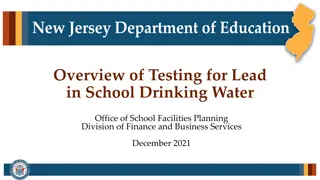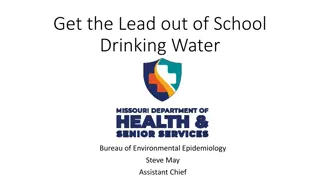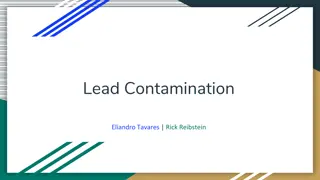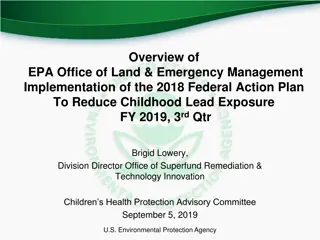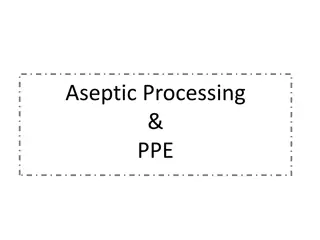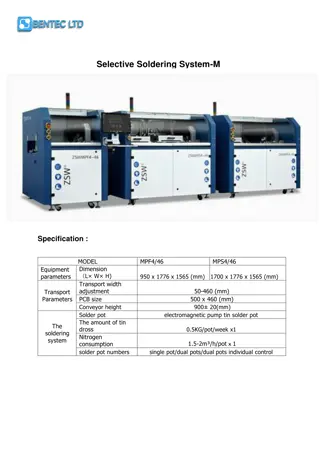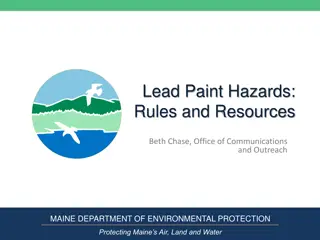Understanding the Economic and Health Impacts of Groundwater Nitrate Contamination in Nebraska
The economic and health costs of groundwater nitrate contamination in Nebraska highlight the challenges of ensuring safe drinking water. Despite largely safe levels, proactive strategies are essential due to rising nitrate levels and costly maintenance efforts. The compliance record shows progress i
0 views • 18 slides
Helping Legislators Get Support for Their Bills To Curb Lead Poisoning
Legislators are pushing for bills to combat lead poisoning, focusing on children under six and lead abatement programs in housing. An event was organized to research legislative gaps and connect with organizations. Key topics include lead in various areas and potential solutions like accessing fundi
0 views • 8 slides
Understanding Risks and Impacts of Methamphetamine and Fentanyl Contamination
Explore the high risks associated with Methamphetamine and Fentanyl contamination, including the severity and frequency factors. Learn about the environmental exposure routes, consequences for occupants, trends, costs, remediation processes, and more.
0 views • 15 slides
Understanding the Impact of Lead Contamination on Human Health and Ecosystems
Exploring the detrimental effects of lead exposure on human health and the environment, this content touches on lead contamination in drinking water, its effects on various bodily systems, and its impact on ecosystems. It also delves into the history of lead usage, major contributors to lead polluti
0 views • 18 slides
Pediatric Lead Prevention Initiative: Best Practices and Screening Performance
This initiative focuses on lead screening in pediatric patients, emphasizing the importance of testing due to the absence of a safe lead level. The program aims to improve compliance with lead testing regulations, including Medi-Cal mandates, and introduce new clinical measures for lead screening. I
1 views • 18 slides
Understanding Food Microbiology: Sources of Contamination
Humans have broader nutritional requirements than most microorganisms. The human diet includes a wide variety of substances, making our food excellent media for microbial growth. Natural contamination of food by various microorganisms, including pathogens, is common. Food consumed by humans and anim
0 views • 51 slides
Ensuring Safe Drinking Water in New Jersey Schools
Highlighting the importance of testing for lead in school drinking water, this overview covers NJDOE regulations, sources of lead contamination, federal drinking water regulations, and NJDOE requirements for testing. Lead exposure poses serious health risks, especially to children and pregnant women
0 views • 17 slides
Guidelines for Maintaining Hygiene in Manufacturing Environments
The article highlights the importance of hygiene in both manufacturing industries and hospitals, covering key aspects such as manufacturing processes, quality assurance, good manufacturing practices, quality control, and microbial contamination control. Environmental cleanliness and hygiene play a c
0 views • 21 slides
Importance of Meat Hygiene and Sanitation in the Meat Industry
Meat hygiene is essential to ensure the safety and suitability of meat for consumers. It involves implementing specific standards and regulatory actions to maintain cleanliness and prevent contamination at all stages of production. Proper cleaning and sanitization practices, adherence to legal stand
0 views • 16 slides
Microbiological Quality Control in Pharmaceutical Environment
Microbiological products in pharmaceutical settings are influenced by the quality of materials and the environment. Good Manufacturing Practices (GMP) are essential to minimize contamination risks, with control points focused on the ecology of microorganisms. Sources of contamination include the atm
1 views • 128 slides
Safeguarding Your Kitchen: Preventing Cross-Contamination
Cross-contamination poses a risk of foodborne illnesses and can occur in multiple ways, such as using the same utensils for raw and cooked foods. Taking specific cleaning steps at home, like regularly cleaning dish cloths and sanitizing surfaces, is vital to preventing harmful bacteria from spreadin
0 views • 8 slides
Risk-Based Environmental Monitoring for Listeria Surveillance at Retail
Explore the importance of risk-based environmental monitoring and decision-making in detecting Listeria contamination in retail food settings. Learn about routine sampling plans, trends in positive samples, species distribution, and key locations of Listeria findings from 2010 to 2014. Discover why
1 views • 12 slides
Managing Microbiological Quality in Pharmaceutical Environments
The quality of microbiological products is influenced by the pharmaceutical environment materials. Good Manufacturing Practices (GMP) play a crucial role in minimizing contamination risks. Various sources of contamination include the atmosphere, water, persons, raw materials, packaging, buildings, a
0 views • 128 slides
Understanding Pyrogen Testing in Pharmaceutical Production
Pyrogen testing is crucial in ensuring pharmaceutical safety by detecting bacterial toxins that may cause fever in humans. Methods such as the rabbit pyrogen test and human response to pyrogens illustrate the importance of quality control measures in production to prevent contamination. By identifyi
0 views • 8 slides
Contamination Notification Training: Florida Department of Environmental Protection
This document outlines the Contamination Notification Training provided by the Florida Department of Environmental Protection in February 2009. It covers types of contamination notification, governing statutes, rules, and guidance, specific noticing requirements, and changes from prior guidance. The
0 views • 25 slides
Methanol Contamination in Indigenous Fermented Alcoholic Beverages: Impacts and Regulatory Measures
Indigenous fermented alcoholic beverages are facing methanol contamination issues, leading to severe health consequences and fatalities worldwide. This article highlights the concerning incidences of methanol poisoning, symptoms, and regulatory limits in various countries. The informal production of
13 views • 27 slides
Addressing Lead Contamination in School Drinking Water
Lead, a toxic heavy metal, poses severe health risks when ingested or inhaled. This article discusses the basics of lead poisoning, its effects on children and adults, and the need for action to remove lead from school drinking water to prevent irreversible health consequences.
0 views • 24 slides
Guidelines on EPA Region 9 Response Action Levels for TCE Contamination
EPA Region 9 has established response action levels for TCE contamination, with tiered concentrations for different exposure scenarios. The State of California provides guidance aligned with these levels. DTSC concurs with EPA's residential and industrial response levels but recommends consultation
0 views • 10 slides
Addressing Lead Contamination: Advocating for Effective Legislation
Working towards effective lead contamination legislation involves setting clear goals, engaging with experts and legislators, expanding testing and awareness efforts, and ensuring existing laws are enforced. Key figures like Senators Chang-Diaz and Eldridge are involved, along with advocacy at event
3 views • 6 slides
Understanding Lead Exposure and Environmental Hazards
Lead, a soft metal abundant in the environment, has been used for various purposes throughout history. Exposure to lead can lead to serious health issues, especially in children. The impact of lead on public health and the environment, including its presence in gasoline and its effects on human heal
1 views • 17 slides
Lead-Based Paint Technical Assistance Overview
This content provides an in-depth exploration of lead-based paint, covering its history, regulations, health effects, and the HUD's Lead Safe Housing Rule. It discusses the dangers of lead exposure, especially to children and pregnant women, and outlines the exemptions to the LSHR. The presentation
0 views • 26 slides
EPA Office of Land & Emergency Management Overview on Lead Exposure Reduction
EPA's Office of Land & Emergency Management (OLEM) implements various programs to address lead contamination, focusing on reducing childhood lead exposure through cooperative efforts at federal, state, tribal, and local levels. OLEM supports an integrated approach to addressing multiple lead exposur
0 views • 9 slides
Groundwater Contamination Rule Amendments Proposal
Proposed amendments to NCAC 15A.2L.0106 focus on establishing default cleanup requirements for groundwater contamination and providing options for remediation. The amendments aim to clarify compliance boundaries, correct terminology inconsistencies, and enhance rule effectiveness.
0 views • 8 slides
Understanding Aseptic Processing and Contamination Control in Cleanroom Environments
Aseptic processing involves maintaining a sterile environment to prevent contamination in cleanroom settings. The presence of non-viable and viable particulate contamination, such as dust and live microorganisms, poses challenges. Sources of contamination include equipment, structures, surfaces, and
0 views • 29 slides
Advanced Selective Soldering System with Flux Spray and Preheating Modules
The Selective Soldering System-M offers precise soldering capabilities with features like individual pot control, flux spray module for reduced contamination, and preheating module for lead-free and multi-layer boards. It minimizes flux consumption and ionic contamination while ensuring high positio
0 views • 6 slides
Lead Paint Hazards Rules and Resources in Maine Department of Environmental Protection
In Maine, the Department of Environmental Protection provides crucial information on lead paint hazards, regulations, and resources. The content covers topics such as disturbing lead-based paint, emergency provisions, federal laws on lead renovation, repair, and painting, disclosure rules, and housi
0 views • 7 slides
Lead Paint Technical Assistance Webinar Overview
Indiana State Department of Health's lead paint technical assistance webinar covered various topics such as new lead-focused programs, state licensing requirements, EPA certifications, federal and state regulations, risk assessments, and policies. It highlighted lead hazard control programs, licensi
0 views • 24 slides
Feasibility of Using Fe0 to Remediate Groundwater Lead Pollution in an Abandoned Tailings Dam
Heavy metal pollution in soil and groundwater from an abandoned tailings dam poses a persistent challenge. This study explores using iron (Fe0) in a Permeable Reactive Barrier (PRB) to remove lead (Pb) via redox reaction. The contaminated area, impacted by lead pollution, underwent experiments to as
0 views • 17 slides
Understanding Contamination in Research Studies
Understand the concept of contamination in research studies, its impact on the effectiveness of Randomized Controlled Trials (RCTs), and different analysis methods to handle contamination, such as Intention-to-Treat (ITT) and Contamination-Adjusted Intention-to-Treat (CA-ITT) analyses. Learn how to
0 views • 40 slides
Guidelines for Animal Disposal Methods
Environmental and biosecurity guidelines recommend various disposal methods such as composting, rendering, permitted landfill, unlined burial, fixed-facility incineration, and open-air burning. Each method has specific selection criteria and considerations to minimize risks to the environment and bi
0 views • 17 slides
Agricultural Water Safety Regulations Overview
The final Produce Rule and Preventive Controls Rule, effective since November 13, 2015, set criteria for microbial contamination in agricultural water. Generic E. coli levels are key indicators, affecting water uses in post-harvest and production. Criteria like Geometric Mean and Statistical Thresho
0 views • 43 slides
Understanding Contamination OCD: Symptoms, Obsessions, and Misconceptions
Contamination OCD is a subset of OCD characterized by severe fears of becoming contaminated by germs or getting sick. Individuals with this condition may exhibit compulsions such as avoidance, excessive washing, and health testing. It's crucial to differentiate between normal intrusive thoughts and
0 views • 21 slides
Understanding Mental Contamination: Causes and Effects
Mental contamination is a phenomenon where individuals experience feelings of internal dirtiness and distress without physical contact with a contaminant. It is common among women who have experienced sexual trauma. Symptoms include fear of imagined contaminants, ritualistic acts to neutralize them,
0 views • 7 slides
Historical Occupational Exposures to Lead in Pre-Industrialized Times
Occupational exposure to lead in pre-industrialized times dates back to ancient eras, with Romans and artisans using lead in various applications. Lead toxicity was observed early on, with artisans like goldsmiths and artists being at risk. Physicians in the Renaissance era recognized the dangers of
0 views • 10 slides
Food Safety and Cross-Contamination Prevention Guidelines
Understanding the flow of food is crucial in preventing cross-contamination at various stages of food handling. This chapter delves into key terms, temperature-measuring devices, calibration methods, and guidelines to prevent cross-contamination. By implementing separate equipment, proper cleaning,
0 views • 23 slides
Best Practices for Contamination Control in Pharmaceutical Manufacturing
Implementing a robust Contamination Control Strategy (CCS) as part of the Pharmaceutical Quality System is crucial for ensuring product quality and safety. The strategy encompasses various elements like process risk management, preventative maintenance, and personnel training. Manufacturers must foc
0 views • 19 slides
Exploring Pesticide Monitoring and Contamination Studies in Maine
Mary Tomlinson's work with the Maine Board of Pesticides Control includes past studies on groundwater and surface water monitoring, ongoing monitoring initiatives, and future collaborative studies. The State Law mandates residue surveys to identify possible contamination sources and develop a pestic
1 views • 55 slides
Radiographic Infection Control in Dental Clinics
In dental radiology clinics, infection control is crucial to prevent cross-contamination and disease transmission among patients and staff. Key steps include applying standard precautions, wearing personal protective equipment, disinfecting equipment, and preventing contamination of processing equip
0 views • 16 slides
Airborne Lead and Arsenic Contamination in Hayden, Arizona Study
Monitoring and analysis of airborne lead and arsenic contamination in Hayden, Arizona revealed significant levels of pollutants stemming from industrial activities. The study site at Hayden High School showed elevated lead deposition fluxes and surface dust contamination, posing potential health haz
0 views • 10 slides
Understanding the Long-Term Effects of Lead Exposure
Lead exposure can have detrimental effects on individuals, especially children. From damaging neurons to causing behavioral issues and slow development, the impact of lead exposure can be severe. Prevention through identifying sources of exposure and living safely with lead is crucial. Lead test kit
0 views • 13 slides






